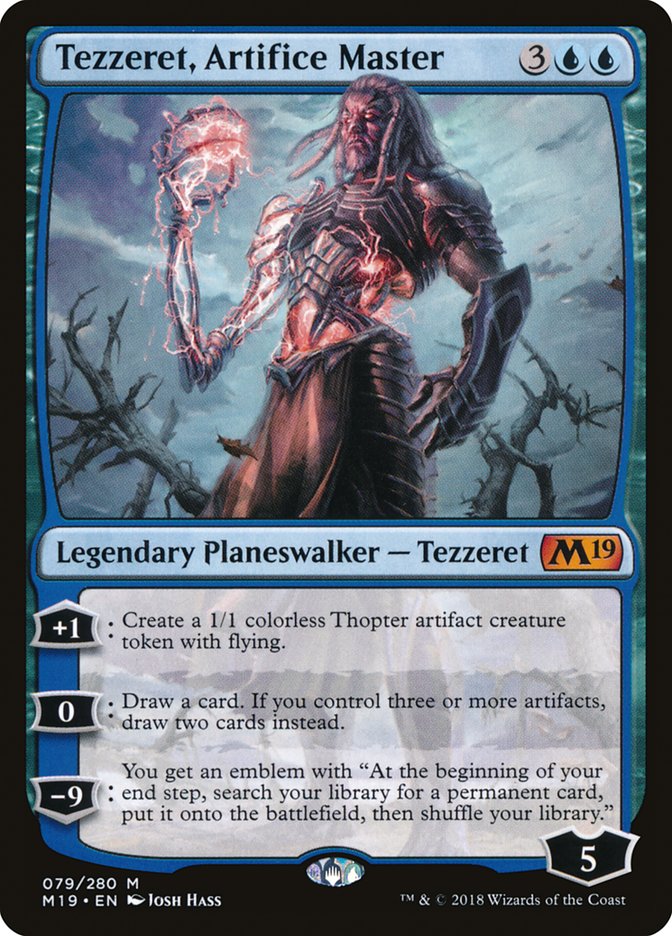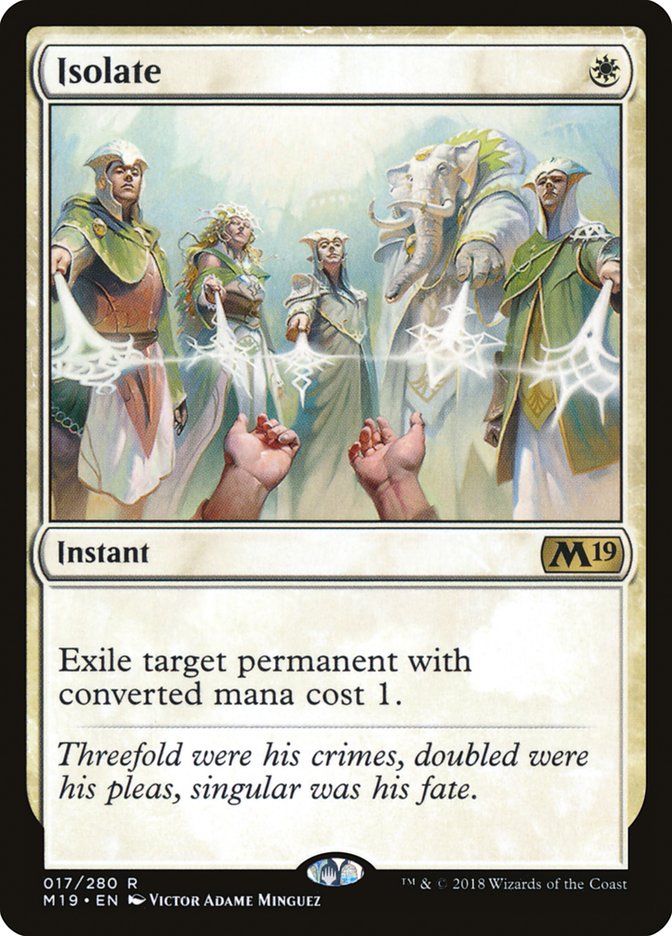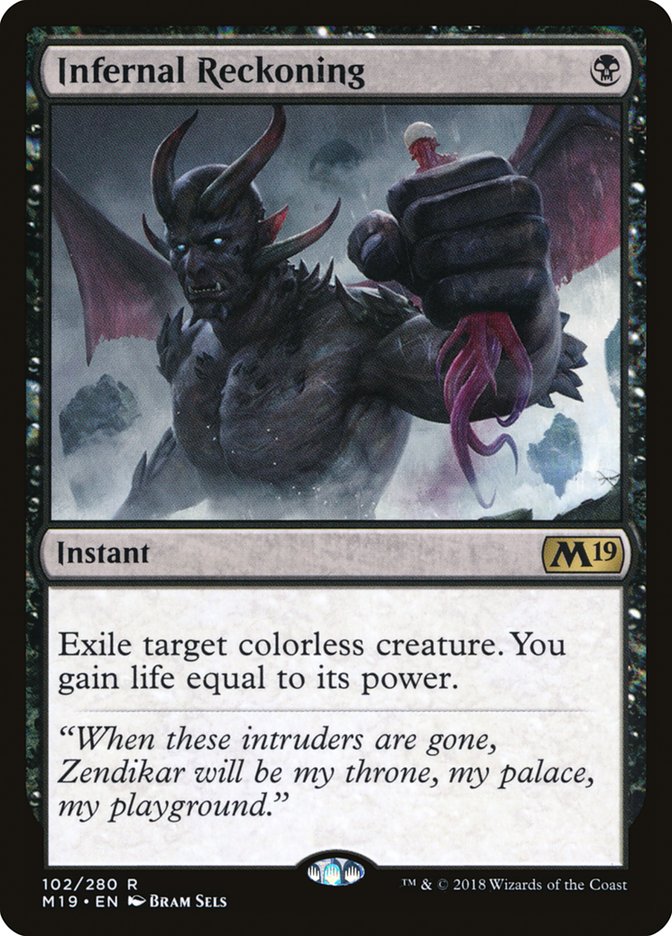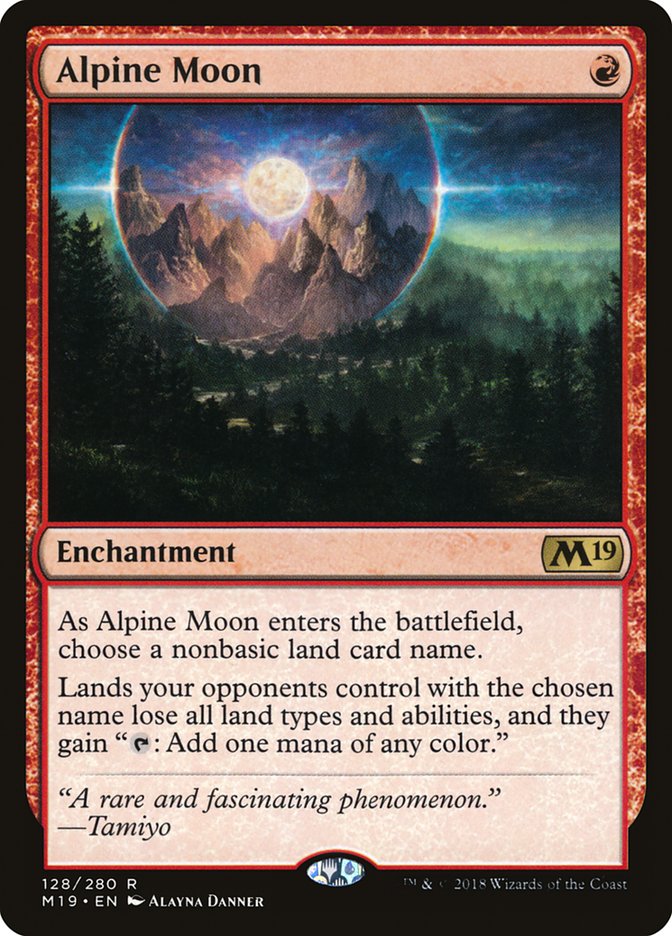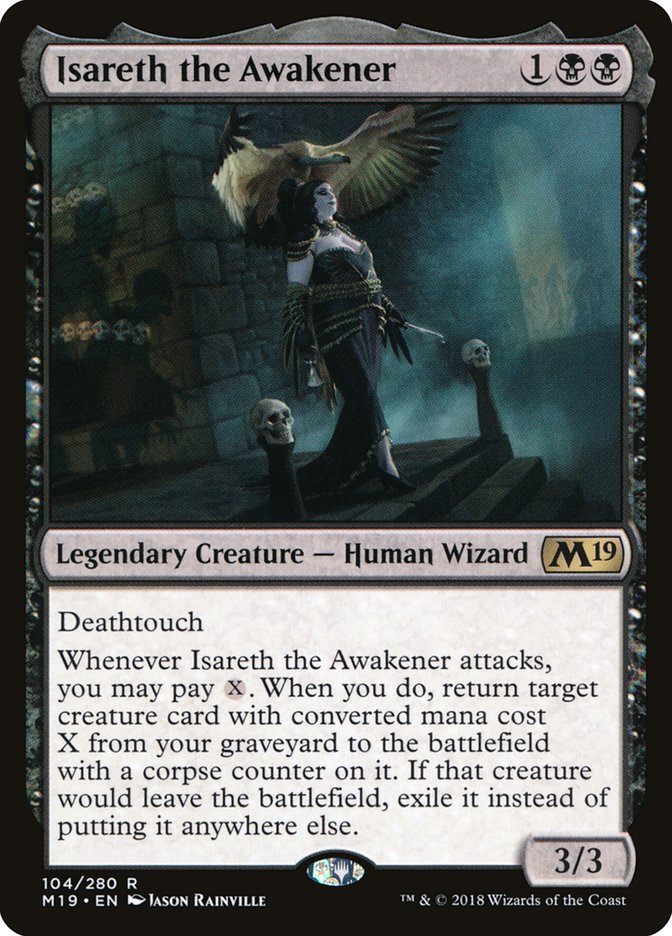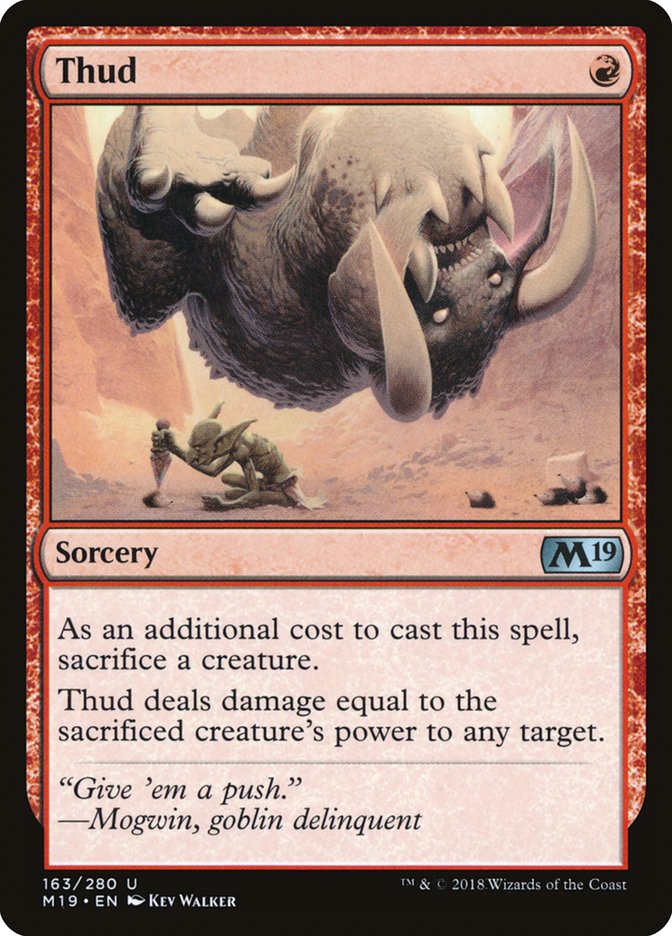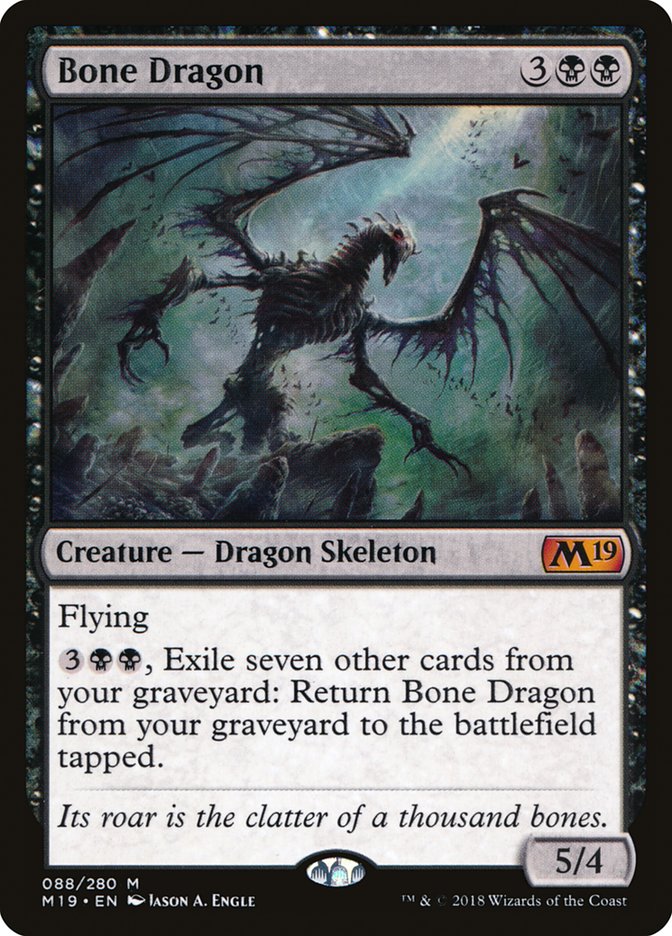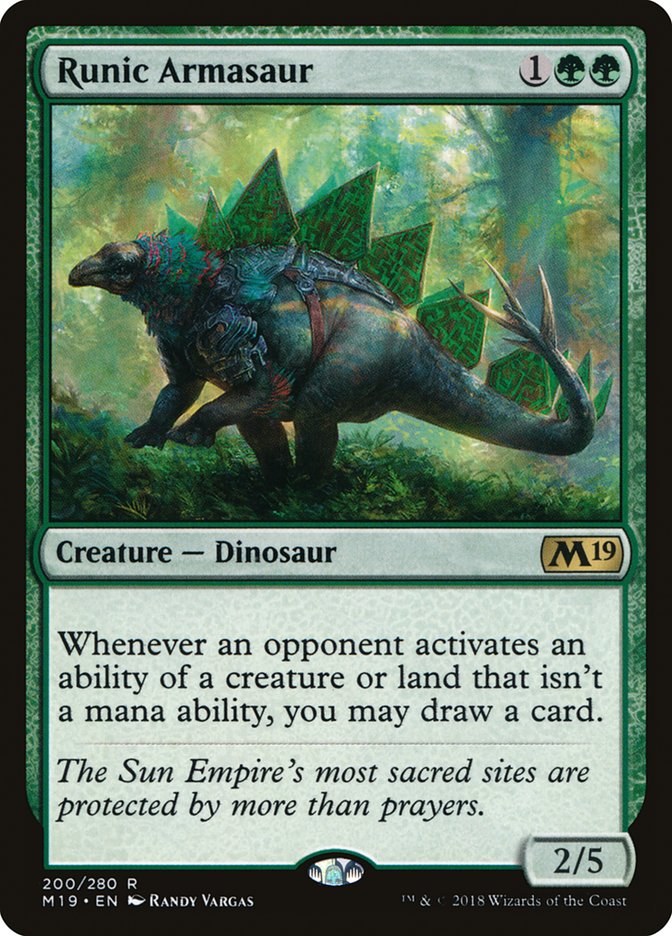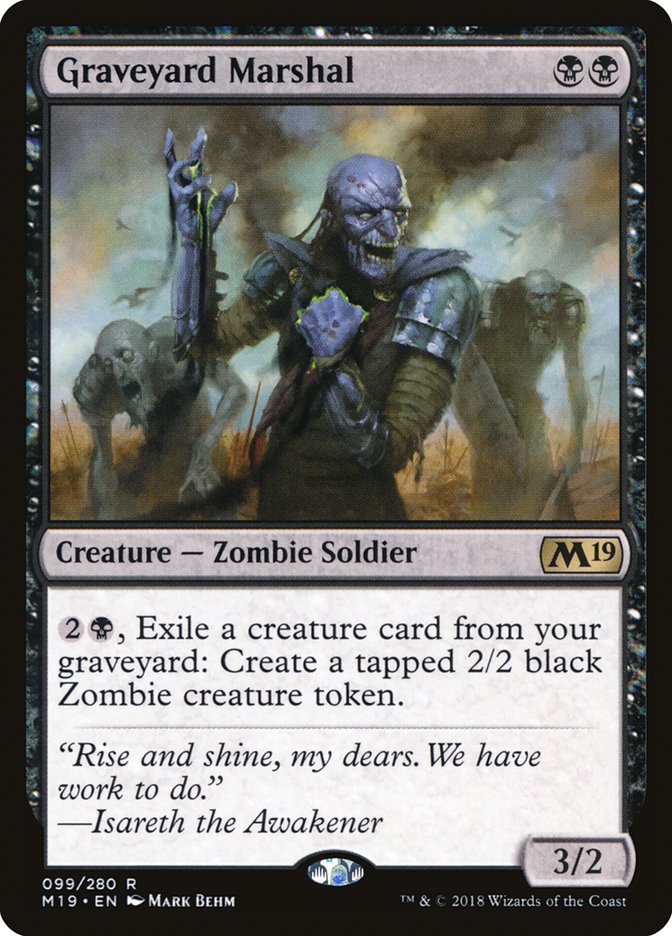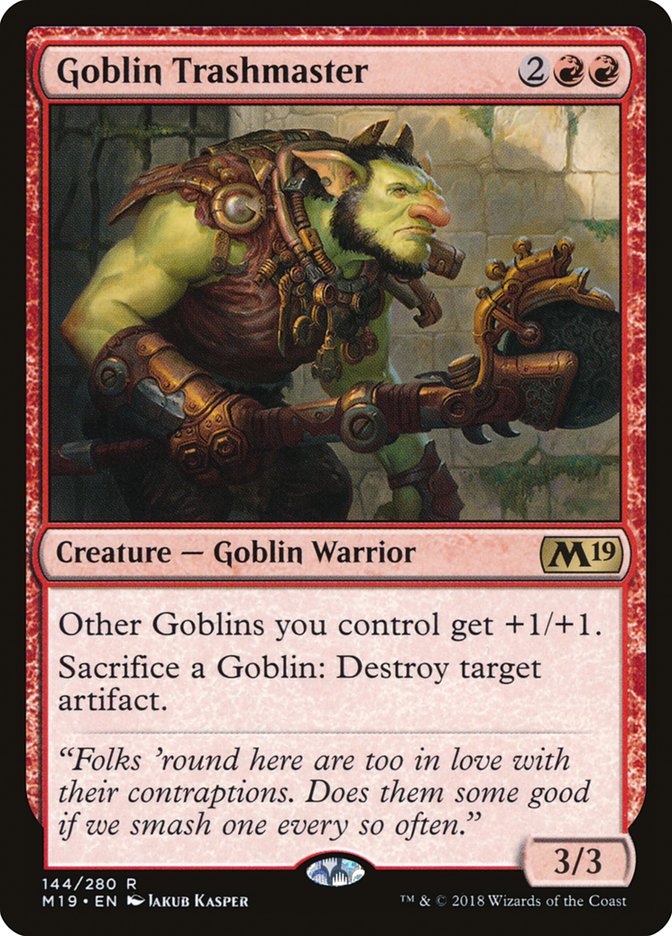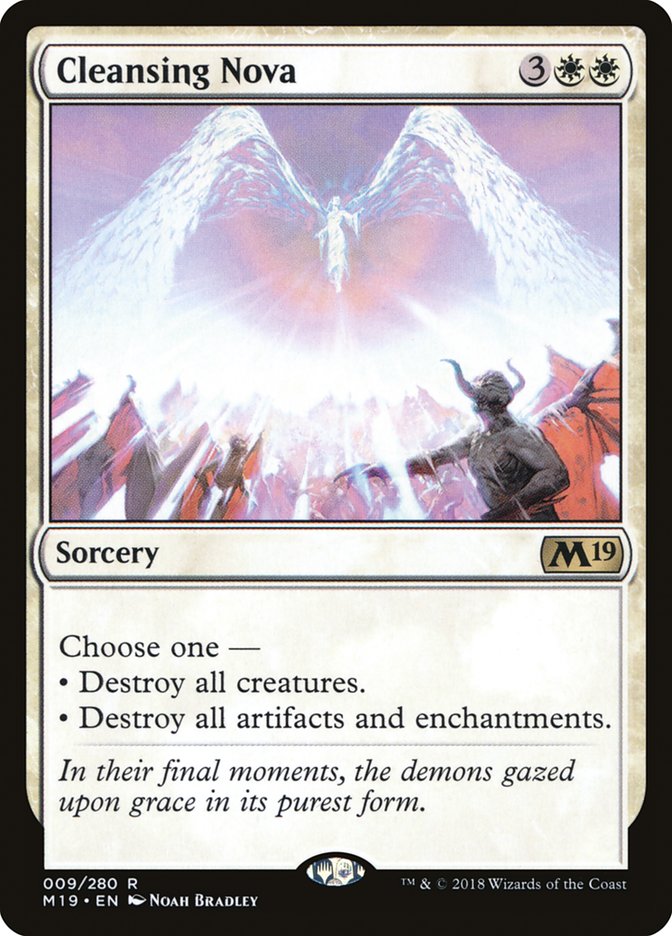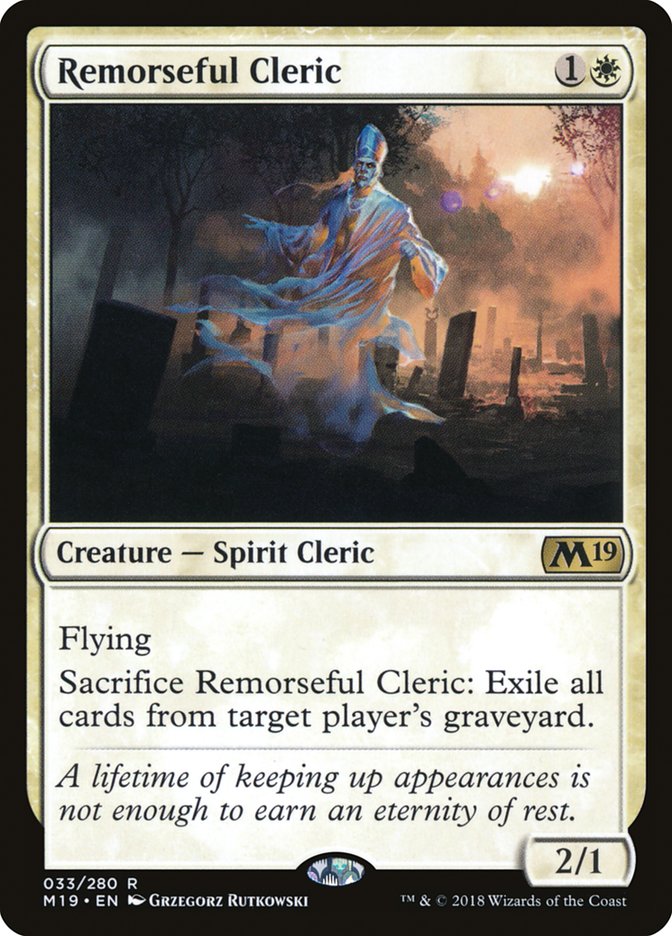Core Set 2019
is almost here, and with it comes a handful of cards I’m pretty happy to
start building decks with. We just had a Standard Grand Prix won by another
Mono-Red deck, with all the classic hits running just a little bit behind.
We had God-Pharaoh’s Gift, The Scarab God, and Teferi, Hero of Dominaria
bringing up the rear. At this point, it feels like if you aren’t playing
blue or red in your deck, then you’re probably doing something very wrong.
But that can change.
With every new set comes a new set of possibilities and new tools to make
existing (or forgotten) archetypes into potentially powerful foils to the
current Standard format. But this time around, Standard isn’t the only
format getting a few goodies to mess around with.
This is a pretty spectacular card on its own.

This ability is particularly powerful in Modern, as small creatures are
usually fine for defending your Planeswalker. For a very long time,
Elspeth, Knight-Errant was one of the best cards in a handful of Extended
and Legacy decks, giving control or midrange a different angle of attack.
And while the cost of Tezzeret is one larger than Elspeth, the ability to
generate flying threats seems particularly sweet.

This ability is above that of Jace, the Mind Sculptor as far as raw card
advantage is concerned. And if you have some way, like Faithless Looting,
to turn those extra resources (lands, etc.) into valuable spells, then you
could turn Tezzeret, Artifice Master into a powerhouse. Drawing two extra
cards a turn is not something we’ve seen before on a Planeswalker,
consistently at least. If you’ve tried to beat a resolved Teferi, Hero of
Dominaria in Modern, you’d realize that raw card advantage is already
fantastic. And while Tezzeret can’t tuck an annoying opposing permanent, he
is only one color and can generate threats that can trade, protect,
pressure Planeswalkers, or actually win the game on their own.

Getting a permanent out of your deck every single turn is somewhat of a
pipe dream. I’ve joked in the past about the ultimate of Jace, the Mind
Sculptor is just “Brainstorm,” because an extra Brainstorm effect is
usually enough to win the game. But yes, when you actually ultimate Jace,
the Mind Sculptor, the game ends. The problem there is that Jace must minus
one loyalty in order to protect itself, where Tezzeret gets to plus his
loyalty to do the same. I don’t want to start comparing these cards,
because the one mana cost and abilities are drastically different, but I
think this card is likely good enough to see Vintage play. And when that’s
the case, I start to look long and hard at the other formats and how I can
garner the full potential out of this card.
Here’s my first go at a “Grixis Tezzeret” deck for Modern.
Creatures (10)
Planeswalkers (3)
Lands (22)
Spells (25)
- 2 Lightning Bolt
- 3 Mana Leak
- 4 Serum Visions
- 2 Terminate
- 2 Spell Snare
- 4 Thought Scour
- 1 Dreadbore
- 1 Rise
- 3 Kolaghan's Command
- 3 Fatal Push
Sideboard

I could be way off base here, but I think Tezzeret, Artifice Master fits
into this shell much better than Jace, the Mind Sculptor. Much higher
starting loyalty, with a plus up to six to create a Thopter, means it will
be a tough road to hoe for any opponent trying to attack it down. On top of
that, the aggressive slant is much more in line with what this deck is
trying to accomplish.
I think the best versions of Tezzeret, Artifice Master in Modern won’t
worry too much about the “three artifact” clause, if only because drawing
two extra cards a turn versus one extra card isn’t a huge difference. The
raw card advantage every turn will be difficult enough to beat, and I could
see a world where continually making Thopters and pushing his loyalty is
all you want to be doing. After all, you can play a pretty aggressive game
with this deck. Gurmag Angler functions a lot like Tarmogoyf in this deck,
and if you can’t see the similarities between my more aggressive Temur Box
decks and this one, then you need to go get your eyes checked. This is not
a Grixis Control strategy. This is a Grixis Tempo strategy, with a few
cards that could help you win longer games. Kolaghan’s Command, for
example, is very good at being a complete blowout against stuff like
Affinity, while giving you some much needed card advantage alongside
Snapcaster Mage.
It’s possible that the counterspells like Mana Leak and Spell Snare are
worse than Thoughtseize and Inquisition of Kozilek, but I think the format
is ripe for some counter-magic again. We’ll just have to wait and see!
I think this card could become a sideboard staple in Modern but could be a
major maindeck player in Legacy. One mana to take care of any permanent
that also costs one mana is much more desirable in older formats than
Standard. As formats grow larger, the card pool of one-mana spells grows
larger, and the list of spells you can play at that cost inherently becomes
stronger. We see this in spades in Legacy, with decks like Grixis Delver
running the place, but that’s not the only deck in the format that has a
huge emphasis on one mana spells.
Aether Vial is a big one, if only because decks that want to play removal also want ways to interact with early problematic permanents.
Hitting Aether Vial is a huge boon for a one-mana spell that can also deal
with both Delver of Secrets and Deathrite Shaman. The list is pretty small,
but when Delver of Secrets and/or Deathrite Shaman take up about a third of
your matchups, having access to a card like Isolate doesn’t sound so bad.
In Modern, the list of cards you can hit isn’t exactly large, but there are
still quite a few goodies you can hit from players’ maindecks.

And with Humans being a major player in the Modern format, taking out
Aether Vial is still a pretty big deal. To me, Isolate feels like a “fixed”
Mental Misstep. It isn’t quite as powerful, but that’s certainly a good
thing, as Mental Misstep is known to ruin formats. Taking out your
opponent’s first-turn play for a single mana, regardless of what permanent
it is, is not something you should ignore. And if there ever comes a time
in the near future where aggressive decks start to overtake the format,
having a one-mana answer that gives you some splash damage for weirdo
permanents like Aether Vial is huge!
Is this card better than Fatal Push? Certainly not, but you don’t
necessarily need to be better than Fatal Push to see play in Modern and/or
Legacy!
This card is a serious “screw you” to Eldrazi, but it comes a little late
in the game. Had this card been accessible during “Eldrazi Winter,” when
Eldrazi ruined the Modern format for two or three months, maybe things
wouldn’t have gotten so bad.
Here’s what I like about Infernal Reckoning: it doesn’t mess around. It’s
very clearly a sideboard card for older formats and can act as a safety
valve if Eldrazi ever becomes “The Best Deck” ever again. With Ceremonious
Rejection in blue and Infernal Reckoning in black, that just might be
enough cheap answers to keep them on their toes, and really punish them for
playing such a linear strategy. And when you start pairing this with
Snapcaster Mage, taking down those types of decks becomes much easier.
This card is an obvious dig at decks like Tron, which needs all three
pieces of Tron lands to function. Naming one of those three lands shuts
down the trio completely. The downside is obvious, in that it gives your
opponent access to colored mana, which can immediately cast Nature’s Claim,
but most of the hosers you play against the Tron decks can be beaten in one
way or another. Either they’re too slow, too easy to kill, or not effective
enough.
Here’s what I like about Alpine Moon as compared to all the other choices:
it’s cheap! In red decks, spells that are cheap must have a reasonable
impact on the game, as you’re taking roughly half of your turn (or more) to
cast it. I like having my hate cards be cheaper because that allows me to
put pressure on my opponent while still being able to cast another spell.
Alpine Moon doesn’t draw a card like Blood Sun or completely shut the door
on some decks like Blood Moon, but it does a fine job at disrupting them
long enough to establish some pressure and hopefully close the door on
them.
I don’t know if this card is quite good enough to see Modern or Legacy
play, but the ability is certainly unique and powerful. When you pair it
with Death’s Shadow, you start to get a sense of how you can really push
this card. When you start combining it with Snapcaster Mage, things get
ugly. And if you’re a Kolaghan’s Command deck, you can keep casting Isareth
the Awakener over and over again, threatening to bring back all the other
creatures your opponent may have killed along the way!
Here’s what I like about this card: It’s another card where cost matters.
The lower the cost of your creatures, the better it gets. When you play
this in Sultai Delver in Legacy, you can bring back hits like Deathrite
Shaman, Tarmogoyf, or even Dark Confidant! If your opponent doesn’t kill
this creature and they’ve killed one of your other creatures already, you
threaten to end the game on the spot (so long as you’ve drawn enough
disruption along the way). I love the fact that this card pairs well with
disruptive threats like Kitesail Freebooter and Tidehollow Sculler,
continuously putting pressure on your opponent to deal with them or lose
their best card.
The deathtouch on Isareth is also nice, because it means their blocker is
definitely dying if their only way to remove it is via combat. Plus, in a
pinch, Isareth can be a fine blocker for an opposing annoyance like Gurmag
Angler or other large monster your opponent might be attacking with.
Cards like Isareth are difficult to assess, because they require some
amount of thought to go into deckbuilding. Do you use it to continuously
bring back small creatures, clearing out their blockers with removal? Do
you fill your deck with cheap must-kill threats like Dark Confidant so that
Isareth actually sticks? Or do you go big and use Isareth like a
pseudo-Zombify, getting back your largest creature(s)? It won’t be quick,
but I expect big things from Isareth the Awakener in older formats. Any
creature that threatens to gain a significant amount of card advantage is a
big deal, and especially so when its converted mana cost is three or less.
I don’t expect big things from Thud, but it seems like a nice Fling effect
for one mana. Sorcery speed is not ideal, but being one mana cheaper is
huge in something like Fling-a-Tog. This card is pretty similar to Temur
Battle Rage, though a bit more dangerous for half the cost. I’m curious to
see if anyone tries it out, but I doubt we’ll see it anytime soon.
I’m not quite sure how good this card is just yet, but it feels pretty
busted alongside the dredge mechanic. Anything that goes from the graveyard
to the battlefield with minimal cost is pretty scary in my book. And while
five mana might seem like a ton, I don’t think it’s all that difficult when
you’re leaning on Life from the Loam. Of course, with Golgari Grave-Troll
making a swift exit from Modern, Dredge has fallen off the map. Perhaps
this card could see some fringe play in decks that use the graveyard a
little bit, but that might be asking too much considering Gurmag Angler
exists.
I haven’t seen a “Value Town” card like this in quite some time! Todd
Stevens must be pretty excited to cast this on the second turn. I wish it
also included artifacts, but drawing a card every time your opponent cracks
a fetchland is already pretty sweet. And as formats get older, cards like
Runic Armasaur can only get better. Just imagine an opponent going all-in
with Arcbound Ravager when you have Runic Armasaur and one mana left up!
We’ve seen the “ability punisher” mechanic before on cards like
Burning-Tree Shaman and Harsh Mentor, but dealing damage isn’t always as
good as drawing a card. This gives different decks the potential to play a
card that generates them some long-term advantage. But honestly, I’d like a
card that punishes people for activating Planeswalkers! And Expedition Map!
And…and…you get the idea.
I don’t expect big things from this card, but I’m a fan of any creature
than can gain incremental advantage over time. The stats are more than
solid, and punishing your opponent for killing your early creatures is
awesome. Is this card better than something like Lingering Souls? Probably
not, but it sure hits hard in the early turns, and drawing multiples is
fine because they’ve likely killed the first one. Again, this is another
card that probably doesn’t fit into an existing archetype in either Modern
or Legacy, but I could see it shining in either format.
An easy inclusion for any Modern or Legacy Goblin deck, Goblin Trashmaster
is an expensive lord that gives you a very cheap way to interact with
artifacts that would do you harm. And while we don’t have Goblin Matron in
Modern (yet), I could see this as an easy tutor target in Legacy. Goblins
isn’t currently a “real” Legacy deck, but I’m sure Jim Davis is hard at
work trying to come up with some way to make Goblins playable again.
With Goblin Warchief and Skirk Prospector making their way into Modern
thanks to reprints in recent sets, the pieces seem to be coming together.
Now all we need is Goblin Matron, Goblin Sharpshooter, and Gempalm
Incinerator to really get the party started! Let’s hope cycling comes back
in the next block or two.
I actually love the idea of playing this in Modern, if only because any
spell that completely wrecks Affinity just makes me happy. Supreme Verdict
is obviously the best of the bunch because it can’t be countered, but any
sweeper that has some utility outside of just killing creatures is a plus
in my book. And with Fracturing Gust already seeing play in Modern
sideboards, I don’t think it’s much of a stretch for Cleansing Nova to
start seeing some play here and there.
Kat Light is probably giggling right now over this card. Her recent finals
finish as the Modern player at the Team Constructed Open in Atlanta earlier
this year has drummed up some hype around Bant Spirits in Modern. While
Caleb Durward is the most notable player to have piloted the archetype,
I’ve played against it a handful of times over the last few years. People
clearly like the deck and having a cheap Spirit with decent stats that can
interact with the graveyard is definitely a plus.
Format all-star? Probably not, but I could see a number of different decks
that want this type of card. White-based aggressive decks of all sorts
should want this over something less intense than Rest in Peace. And if you
happen to care about your own graveyard, this can act similarly to Tormod’s
Crypt with a free 2/1 body attached.
***
Aside from the cards listed above, I’m certain there are a handful of
useful cards from this set that could see play here and there in Modern.
Nothing really stands out to me as “multi-format all-star” other than
Tezzeret, Master Artificer, but that doesn’t mean I’m right! And that’s the
beauty of a new set of Magic cards. Creatures that look menacing can often
flop. Instants that look innocuous could go on to be format-defining. Just
look at Fatal Push!
While Core Set 2019 isn’t part of an overarching story spanning
the course of an entire year, the lore behind a lot of these cards feels
like coming home. With Dominaria hitting so many of my buttons and
lot of throwbacks being printed in the set, I’m happy with how it looks as
a whole. And with a few spicy reprints…
Modern is currently the format with all the buzz around it. Y’all love it,
and I want to see new cards thrive. I want more sideboard spells. I want
more removal spells with cross-format play. I want creatures that are good
enough to break through all the nonsense without being too oppressive. It’s
a fine line to walk as a member of R&D. I’m really digging this set,
and I hope you are too.
And if you think any of the cards I left off the list could see some Modern
play, hit me up. I’d love to see some decklists incorporating new cards!


